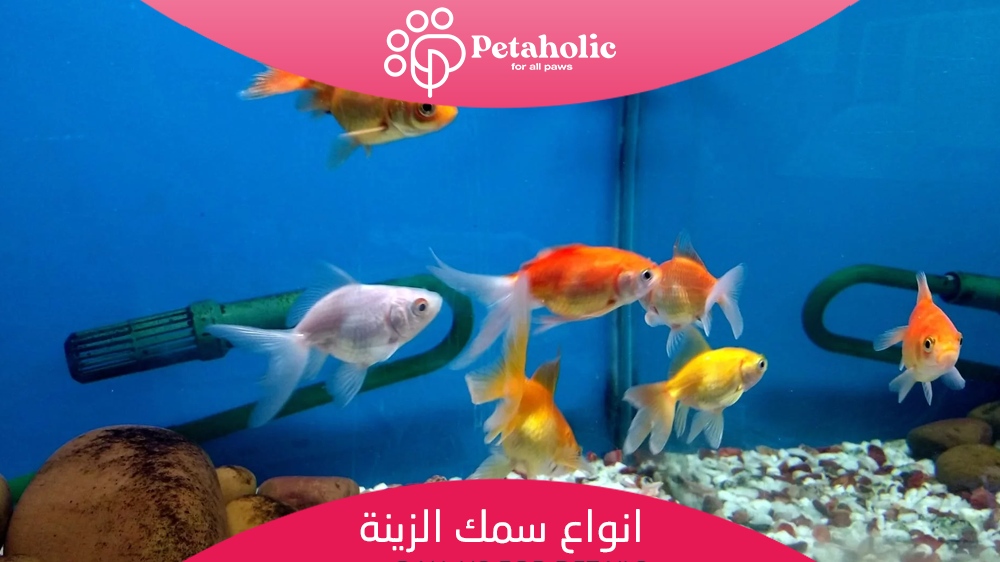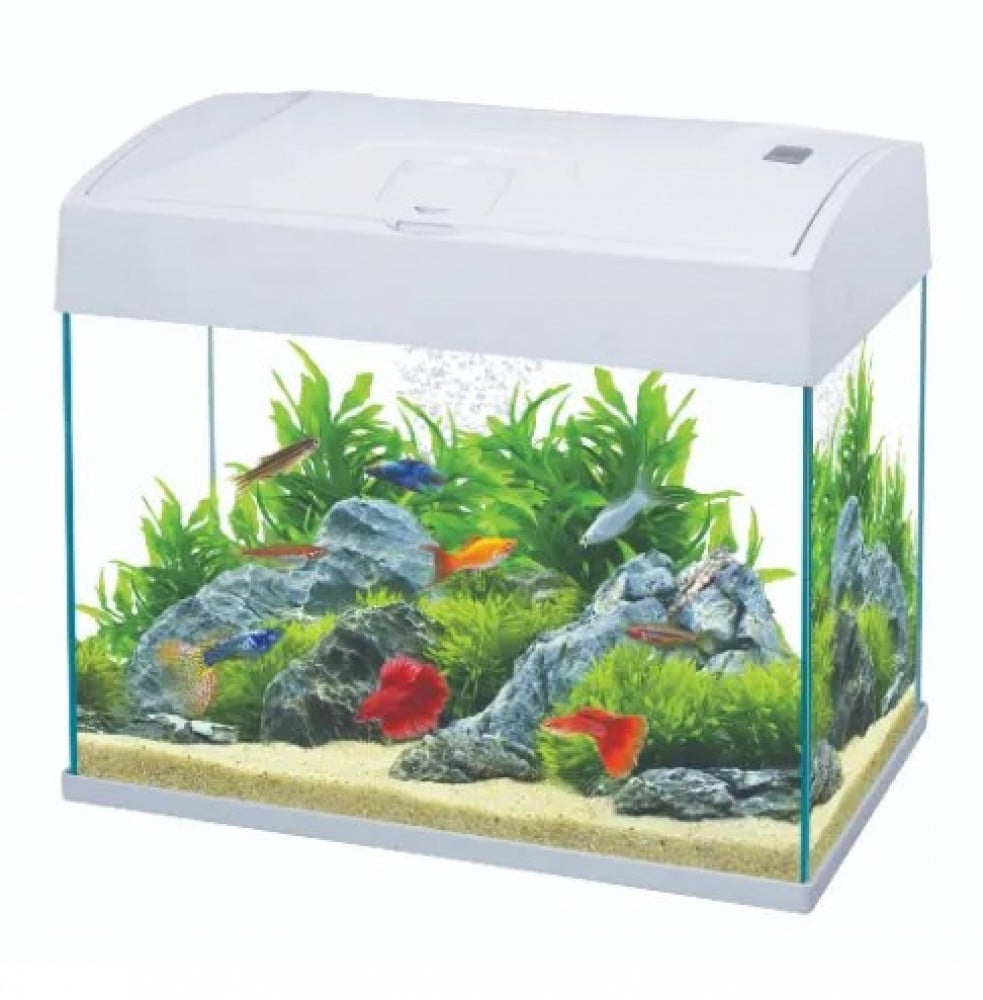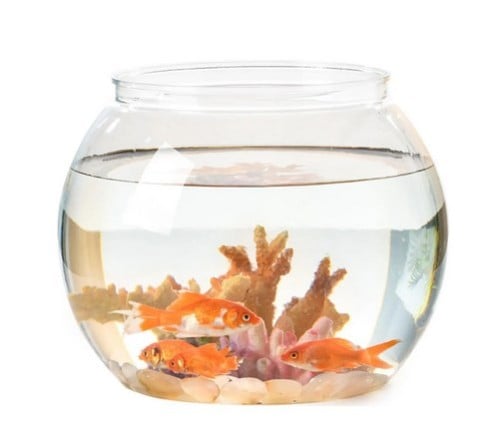
An aquarium can be a beautiful addition to your home, especially when it is a thriving, active ecosystem with different species of fish swimming peacefully together. However, if you're not careful, the fish you add to your tank may end up fighting and killing each other, with larger fish eating smaller fish, and smaller fish hiding instead of exploring their environment, so how can you find fish that live well together? In this guide from Petaholic , we show you the types of aquarium fish that can live together in peace in one tank.
What species of communal aquarium fish can live together in one tank peacefully?
Here are the most prominent types of community ornamental fish:
1. Guppy fish
Guppies are one of the most common types of ornamental fish that can be raised in aquariums with other species. These fish are distinguished by their small size and colorful varieties, which make them an ideal choice for beginners and experienced fish keepers alike. Guppies can live up to two years and grow up to 6 cm. They are active swimmers and jump frequently into the water, adding a lot of life and movement to the tank. Also during the mating season, many male guppies shake their fins to impress females. While females are usually grey, male guppies come in bright colors, spots, and stripes. Since their natural habitat is freshwater, your tank should be as natural as possible.
2. Striped Danio
Danios are very social aquarium fish, so they are an ideal choice for aquariums containing other species of aquarium fish. Striped danios can be found in many colorful hues, with a maximum lifespan of 5 years, so these fish are easy to care for and will last a long time. In fact, danios are so social that they stay close to their tank mates and constantly keep them company for social reasons, and they are playful and non-aggressive. However, these fish chase each other in the fish and can sometimes be aggressive around fish with slow-moving fins. Again, creating a natural freshwater habitat for these fish is key to reducing their aggressive behavior. Also make sure it has a good filtration system, wood and aquatic plants to mimic its natural underwater environment.
3. Tetra fish are among the best types of social ornamental fish
Tetras like to live in peaceful communities. They are active freshwater fish with dazzling colors. As a non-aggressive fish, this fish usually stays in groups in the middle level of the tank, and prefers a warm, densely planted, calm tropical environment. You can place small pebbles and rocks under the water, and make sure that the bottom layer of the aquarium is dark. Tetras are very peaceful and friendly, except when the mating season begins. Since they like to stay in groups, they add an attractive array of vibrant colors to the aquarium. Since they are small, be sure to place them with other small, non-aggressive fish; Any fish larger than a tetra should not be placed in the aquarium.
4.Swordtail fish
Swordtail fish are known for their delicate fins and sharp tails. They are a popular choice among peaceful, social aquarium fish and are easy to care for. Mostly known as green or red swords. Since it is medium in size, it does not need much space; However, their active nature will definitely enjoy more space. The best male to female ratio for a swordtail aquarium is one male for every three females to try any potentially aggressive behaviors. However, these fish like to stay in groups, so always offer five or more of them at a time.
5. Gourami fish
Gourami fish are a unique and charming species of fish with distinct mouths and personalities. Although they can be a bit aggressive, they tend to behave well when kept in well-supervised aquariums. They are prone to fighting over territory, but the good news is that fighting decreases dramatically once the fish mature and have clearly defined territories. So always pair them with fish of the same size to avoid aggressive fights in the tank, and rest assured that such fights are extremely rare. These fish usually live in the upper and middle levels of the aquarium, where the water is sluggish. They also prefer dark, dense plants and a soft substrate which you can get from our store. They may not need an air pump because they do not like strong currents.
If you are looking for a large, high-quality tank in which you can raise a variety of fish species, we recommend:
How do you know the male from the female in ornamental fish?
In ornamental fish, it can sometimes be difficult to identify a male from a female, especially if the fish does not show clear sex differences. However, there are some methods that can be used to attempt to determine sex in some fish species. It is noted that these methods are not 100% accurate and may depend on the type of fish and its degree of growth.
1. Examine body shape: Males may have more fused bodies with fins and tails, while females have more supportive bodies.
In some species, males' fins may be larger and more prominent.
2. Body color: In some species, the color of males can be brighter or have slightly different colors.
3.Fin shape: In some species, male fins are larger or more buckled.
4. Fish /strong> In some cases, behavior can be an indicator of sex, as males may be more active or display reproductive behavior .
Please keep in mind that these methods are not always accurate, and may require a little experience to correctly determine the gender. Sometimes, it's better when the fish mature and the sex differences become more apparent.
Do ornamental fish eat each other?
Yes, sometimes aquarium fish can attack each other and eat parts of the fellow fish's body. This behavior occurs more commonly in some species of fish and depends on the breed and conditions in the aquarium.
Here are some reasons that may lead to this /span>
-Territorial Aggression: When aquarium fish live in a limited space, such as an ornamental tank, some fish can develop an associational stress toward their space and begin attacking other individuals.
Hierarchy: Sometimes aquarium fish form a hierarchy in which some fish are superior and are tolerated, while weaker individuals are attacked.
Hunger or lack of food: In the event of a lack of food, some fish may attack other individuals to obtain food.
To avoid this behavior, it is preferable to provide sufficient space for the fish, provide hiding places and shelters, and ensure the availability of a sufficient amount of food. If you notice that your aquarium fish are showing unwanted aggressive behavior, it is best to find the cause and take the necessary measures to improve the conditions in the tank.
What are the best types of ornamental fish?
Choosing the best type of aquarium fish depends on the individual needs and preferences of the aquarium owner, as well as the conditions in the aquarium itself. Here are some common species that are popular as ornamental fish:
Neon Tetra : One of the beautiful and colorful ornamental fish. It can be placed in small to medium-sized tanks.
Gourami: Offering different types, they are known for their unique designs and interesting behaviour.
Barbs : Available in several types and colors, they are lively and active in the aquarium.
Queen of Ladders (Betta Fish): Also known as betta fish, these fish are beautifully colored and have strong individual personalities.
Platy fish : characterized by its diverse colors and ease of care.
Serpae Tetra: They offer a beautiful red color and are gregarious in the aquarium.
Cichlid Loach: Available in different types, it is famous for its bright colors and unique shape.
Angelfish: Beautiful shape and unique fin shapes.
Hyphessobrycon erythrostigma: Sometimes known as the pink tetra, the Hyphessobrycon erythrostigma is a beautiful, peaceful aquarium fish.
Sitonia (Corydoras) : Small and active bottom fish, suitable for keeping the bottom clean.
Before choosing a type of fish, check the tank's requirements, and inquire about the fish's behavior and nutritional needs. Make sure to provide an environment suitable for the type you choose and to consult professionals in the relevant stores.
Can aquarium fish live without a filter?
Some aquarium fish can live without a filter, but this depends on the size of the tank, the number of fish, and the extent to which the tank owner uses other techniques to maintain water quality. Filters are used in ponds for several reasons, including:
1. Water purification: Filters help remove impurities and suspended particles in the water, which improves water quality.
iAquarium 20 liter glass aquarium with filter - white
2. Aeration: Filters help provide airflow to the water, which helps deliver oxygen to the water and improve aeration.
3. Desalination of water : Some filters contain desalination media that help rid the water of harmful chemicals.
Without a filter, water quality problems can increase over time, increasing the possibility of health problems for the fish and deteriorating conditions in the tank. If you intend not to use a filter, you must carry out frequent water changes and carefully monitor its quality.
Make sure to provide adequate ventilation and clean the aquarium regularly. This may be possible in small tanks with a small number of fish, but in large tanks or with a large number of fish, it is preferable to use a filter to ensure a healthy and stable environment for the fish.
Why is it important for fish to get along in an aquarium and why do fights break out between them?
This question may seem obvious, but it is important to understand community living among the most beautiful different types of ornamental fish . When you collect different species of fish, you are creating a new habitat for them from scratch. You have the responsibility and power to make sure the tank is functioning properly, especially how different fish interact with each other. Aggressive species that don't get along well can cause a great deal of stress in the tank. Also, sometimes, aggression can escalate into bullying or killing of other fish species. It is therefore very important to only group or pair species that are compatible with each other. Those who prefer isolation should be kept in a separate tank. You should also know the causes of fights between fish and each other to avoid them.
Like other species in the animal kingdom, fish fight for three reasons:
- Territory: Some fish species are more territorial than others, especially if the tank is very small. They start chasing other species to free up more space.
- Resources: Fish can be very competitive regarding food, plants, and rocks. Those who do not get along well form a rivalry and chase each other into the aquarium.
- Mating: Many species are very aggressive regarding their breeding rights. If they feel threatened, they will fight each other.
To provide the most peaceful environment for your various ornamental fish, an ideal filtration system must be provided, and here we recommend for you:
Hence, it is very important to know the mating, resources and territorial needs of each species so that you can group them together peacefully. While we've mentioned the most common social aquarium fish in this guide , building a suitable habitat is key to peaceful coexistence. You can provide all the basics and supplies to achieve this purpose from our store in Petaholic, where we provide all high-quality fish supplies at the best prices and fastest delivery.
You may also be interested in:
- The most beautiful types of ornamental fish suitable for breeding
- What are the basics of caring for an ornamental fish tank?



